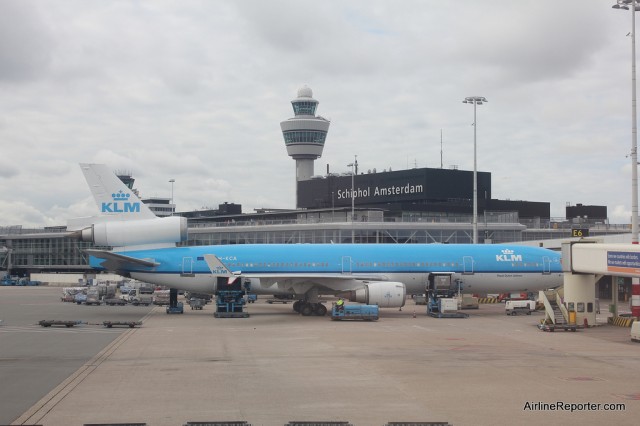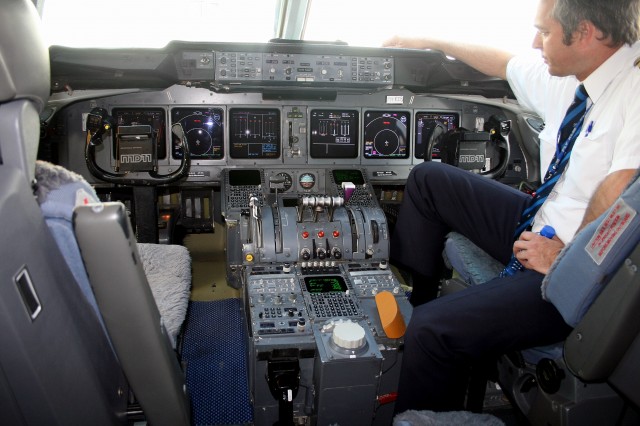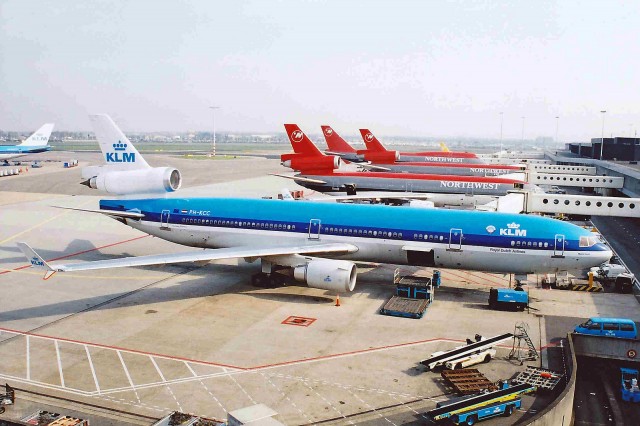This is a guest story by Drew Vane on the classic MD-11.
In July of this year, KLM started retiring their fleet of MD-11s with plans to replace them with more fuel efficient aircraft. “Phasing out the MD11 forms part of KLM’s ongoing fleet renewal programme,” a KLM spokesperson explained to AirlineReporter.com. “The last of KLM’s ten MD11s is expected to leave the fleet by the end of 2014.” For the long term, KLM plans to replace the MD-11s with 787-9s, but until then, they will Boeing 777s and Airbus A330s.
In my last article, I highlighted the DC-9 and its impending departure from the commercial skies. I’d thought its time was coming to a close, but Delta surprised me by extending the DC-9’s usage an additional year, but it looks like KLM won’t be delaying their MD-11 retirements.
Once KLM phases out the MD-11, there will be no other commercial airline flying this widebody tri-jet for scheduled passenger service. It’s anticipated that only few cargo and charter airlines will use the MD-11 in their fleet before disappearing from the sky forever.
The MD-11 came about when the aviation engineers at McDonnell Douglas decided an upgrade to the DC-10 was warranted. Instead of inventing a new aircraft, McDonnell Douglas took an already existing popular wide-body aircraft, whose biggest user and launch customer was American Airlines, and made it better.
The DC-10 was plagued with poor media attention due to some catastrophic failures in the 70’s and 80’s, including the worst commercial air disaster in US history, the loss of American Airlines Flight 191. With that flight, a DC-10 rolled over following takeoff and crashed in Chicago on May 25, 1979 which resulted in 270 deaths.
New technological advances had a major impact on what led to the DC-10 Super 60 project, what would eventually become the MD-11. Boeing’s website best describes what exactly made the MD-11 better than its predecessor. Specifically it states that the MD-11 has ’œadvances in aerodynamics, propulsion, aircraft systems, cockpit avionics and interior design.’ What does all the mean? Well, a leaner and meaner version of the DC-10. Here is a summary of the modifications:
- Advanced Cockpit: Fly-by-wire technology, CRT displays, dual flight management system computer (eliminates need for a flight engineer), hydraulic fuses to prevent loss of control in catastrophic conditions, central fault display system, GPS, and Cat III automatic landing capability for extremely bad weather.
- Composite Materials: Usage of light weight composites reduced overall weight and allowed for a fuselage 40 feet longer than the DC-10.
- Aerodynamic design: Added winglets produce 2.5% more efficiency in drag as well as wing and tail improvements.
- More efficient engines: More efficient aircraft engines were developed by Pratt & Whitney, GE and Rolls Royce. New engine types resulted in greater thrust as less fuel usage and longer range.
The table below highlights how these improvements directly related to a longer range and more efficient aircraft. To make things apples to apples, I’ve chosen versions that were the best of each aircraft type.
|
DC-10-30 |
MD-11 ER |
|
| Cockpit Crew |
3 |
2 |
| Passengers (3-class) |
255 |
293 |
| Passengers (2-class) |
285 |
323 |
| Maximum Range (full load) |
6,600 mi |
7,240 mi |
| Maximum Cruise Speed |
Mach 0.88 |
Mach 0.88 |
| Maximum Takeoff Weight |
572,000 lbs |
630,500 lbs |
| Maximum Fuel |
36,650 gallons |
38, 615 gallons |
| Engines – Thrust |
PW4462 – 62,000 lbf |
PW JT9D-59A – 53,000 lbf |
| Fuselage Length |
170 ft |
192 ft |
| Wingspan |
165 ft |
169 ft |
So, what we have is a longer range aircraft that is capable of carrying more passengers with less crew and a state-of-the-art cockpit.
If you want to catch a ride on one of these ’œMighty Dogs’ after KLM retires their 9 remaining aircraft, short of buying your own, you’ll have to fly on a charter flight or ship yourself via Fedex, UPS, Eva Cargo or Lufthansa Cargo.



End of an era. Love that plane!
The engines are transposed…
DC-10 PW JT9D
MD11 PW 4462
Here you can see the actual pictures of the first MD11 (PH-KCH) leaving Amsterdam for Victorville to be scrapped.
http://md-eleven.net/Latest-News-
Great link Peter. Thanks for sharing!
Do not forget that World Air Ways still flys many US troops on MD-11’s.
They do, but it is not a scheduled service, so much more difficult to get a flight on one in the future.
David
Ahh, love this plane. A shame I never got a chance to fly on it. I live in a city where KLM sends the MD-11 daily and never get sick of seeing it… I understand why this must be done though.
Well, you still have some time 🙂
David
darn…
I had heard of the impending retirement from Brett over at CrankyFlier so I actually went out of my way to fly on one last year. The Delta reps where confused why anyone would be asking for DEN-CVG-YUL-AMS-MSP-DEN, but it was all for that YUL-AMS leg on the MD-11. I took my little brother as well, but not for the plane, I took him to show him Europe. We sat back near the tail, enjoyed a relatively light load in coach and the great KLM service. It was a great flight and one I’m very glad I managed to fit into my schedule.
Have any photos to share?
David
I do. I will write myself a note to pull them off my network drive tonight.
David –
Here are the photos of the KLM MD-11 arriving at YUL for my brother and my YUL-AMS flight as well as a picture from my seat at the back of the bus.
http://www.flickr.com/photos/jhancock_00/sets/72157631306192792/
Got to fly an MD-11 one time, AA DFW-MIA, took that flight just for the chance to fly that bird…certainly one of the most muscular, handsome planes ever to take the skies…
Sorry to see KLM let them go, but they are old birds and their best days are behind them. RIP MD-11
Am surprised that this airplane is still flying commercially. It may have been a great flying airplane but it was a very poor performer from the start. MD should have committed to a new airplane. They may still be in business if they had.
High fuel costs, but no loan payments. The MD-11’s interiors are out of date and probably makes business sense for KLM to get rid of them.
David
Sorry to spoil the “lovefest”, but as a former MD11 pilot (1996-2004) I will not be sorry to see it end up in the smelter. This aircraft had a horrible machine-human interface combined with unimpressive flying characteristics. An overall engineering kludge. Reading the “summary of modifications” above, I find it interesting that MD appears proud that hydraulic fuses were included in the MD11. The DC10 should have had them in the first place (the L1011 did), but the Douglas engineers decided that loss of all hydraulic systems was a statistical impossibility (the same geniuses that routed the hydraulic lines in front of the spar). This is the aviation equivalent of Ford’s decision to install fuel tank piercing bolts on the Pinto. But I digress…
One man’s treasure is another’s trash :).
It is good to have multiple perspectives. I am sure most passengers will be happy to see this bird go away, but there is something about those tri-holers.
Were you ever able to fly the DC-10 as well?
David
No, I never flew the DC10. Although it had some unconscionable design flaws, apparently the DC10 was a nice handling bird according to what I have been told by friends who flew them.
The MD11 was originally certified by the FAA with the DC10 wing and a tiny horizontal stab (tiny compared to the DC10) that was pumped full of fuel in cruise to create an aft CG condition. A system called LSAS was required to overcome the aerodynamic deficiencies of the minuscule horizontal stab. Again, it was a complete kludge. Google “MD11” and “LSAS” to learn more.
Treasure and/or trash? Ironically I made a very nice living for all of those years flying that aircraft. But I’ve got to be honest about it, especially when I read the misty-eyed tributes. The flying public should be glad the MD11 is going away.
BTW, I agree that there is something about tri-holers. Flew the Tri-Star for 4 years. What a magnificent aircraft!
Keith
This article inspired me to book the last pax MD-11 flying to North America, KLM 621 from AMS to Montreal. Flying the inaugural UA 787 long-haul IAH-AMS over so it will be a nice comparison. I haven’t been on an MD-11 since 1999 on American. As a passenger, I used to love it!
Talk about an interesting perspective. Flying on the world’s newest airliner to return on one of the oldest still operating.
Want to write a story on the comparison for AR.com 🙂
David
Interesting! I’ am wondering how much unit cost is saved by investing into a Dc-10 from a MD-11
Sure thing, David. Be glad too! It sure was a pain to book it. ATL is switching to a 777, even though it’s an MD11 at this point. SkyTeam Res thought I was crazy!
Had the great priveledge to fly on KCA,KCD and KCG
Will miss them all when they go – thanks for great long lasting memories
and flights.
We flew KLM MD-11’s many times on the AMS-Nairobi flight – wonderful memories.
Headed the specificationteam of KLM, and was on the deliveryflight of PH-KCB, 8 Dember 1993. Our(KLM) fleet flew more than 20 years !!!!!!!
Was surprised to find that my first ever flight (Swissair LHR-ZRH) was a stand in MD-11. Good memories and sad to hear this news
Worked on everyone of the MD11 and was also apart of the original DC10 MD11 Freighter conversion in Long Beach for FedX
I have flown many times on the MD11 route AMS/YVR/AMS using KLM – I found the aircraft comfortable and smooth. My next trip to YVR will be on the B777 so BYE BYE MD11
Its sad to see them go:( I am in flight school and as a child always wanted to someday fly one, but now I know ill never get that dream:'(
I was a passenger on the KLM YUL-AMS route onboard MD11 for many years. These days I’m flying Air France YUL-CDG just to avoid the MD11.
Unfortunately I’ve had my fair share of KLM MD11 breakdowns including a mid-Atlantic engine failure and a couple of times when they couldn’t get the luggage door shut.
In one year I can start to fly with KLM again. I miss Shiphol but I guess anything is better then CDG 🙂
its about time this plane is old in every way not very reliable especially lately at YUL
I watch FedEx 463 leave every morning and 308 come back every night. What I see is a classy, under appreciated bird touching down gracefully for the compliments of a bunch of packages. It seems like kind of a shame, really. I have always admired this tri-jet, and am sad to see it retire. To folks like me, it’s not just a jet being retired, but a sign of the end of an era. It’s like losing an old friend.
Many difficult engineering feats were accomplished and regulatory inhibitions were amended because of new standards imposed by this aircraft. The CF6-80c2s or PW4462s being hung on it were (as any new engine can claim) the most fuel-efficient and reliable offered at the time; therefore on oceanic routes, it needed only 3 engines rather than 4.
Maybe it was more evolutionary than revolutionary, but it certainly is a dignified airframe. Maybe outdated cosmetically, but refined aerodynamically. That’s not solely because of the age of the interior, but also a lack of updating. Similarly, any reliability issues are more accurately attributed to improper maintenance than age. The USAF still flies 50-60 year-old aircraft. There are 50+ year-old DC-8s still flying with very high-reliability.
I will climb down from my soap box now, relieved. She flew millions of passengers, grateful or not, to their destinations with a high standard. She will be missed.